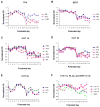Peripheral-central chemoreceptor interaction and the significance of a critical period in the development of respiratory control
- PMID: 22684042
- PMCID: PMC3467325
- DOI: 10.1016/j.resp.2012.05.026
Peripheral-central chemoreceptor interaction and the significance of a critical period in the development of respiratory control
Abstract
Respiratory control entails coordinated activities of peripheral chemoreceptors (mainly the carotid bodies) and central chemosensors within the brain stem respiratory network. Candidates for central chemoreceptors include Phox2b-containing neurons of the retrotrapezoid nucleus, serotonergic neurons of the medullary raphé, and/or multiple sites within the brain stem. Extensive interconnections among respiratory-related nuclei enable central chemosensitive relay. Both peripheral and central respiratory centers are not mature at birth, but undergo considerable development during the first two postnatal weeks in rats. A critical period of respiratory development (∼P12-P13 in the rat) exists when abrupt neurochemical, metabolic, ventilatory, and electrophysiological changes occur. Environmental perturbations, including hypoxia, intermittent hypoxia, hypercapnia, and hyperoxia alter the development of the respiratory system. Carotid body denervation during the first two postnatal weeks in the rat profoundly affects the development and functions of central respiratory-related nuclei. Such denervation delays and prolongs the critical period, but does not eliminate it, suggesting that the critical period may be intrinsically and genetically determined.
Copyright © 2012 Elsevier B.V. All rights reserved.
Figures




References
-
- Aicher SA, Kurucz OS, Reis DJ, Milner TA. Nucleus tractus solitarius efferent terminals synapse on neurons in the caudal ventrolateral medulla that project to the rostral ventrolateral medulla. Brain Res. 1995;693:51–63. - PubMed
-
- Amiel J, Laudier B, Attie-Bitach T, Trang H, de Pontual L, Gener B, Trochet D, Etchevers H, Ray P, Simonneau M, Vekemans M, Munnich A, Gaultier C, Lyonnet S. Polyalanine expansion and frameshift mutations of the paired-like homeobox gene PHOX2B in congenital central hypoventilation syndrome. Nat Genet. 2003;33:459–461. - PubMed
-
- Baker-Herman TL, Fuller DD, Bavis RW, Zabka AG, Golder FJ, Doperalski NJ, Johnson RA, Watters JJ, Mitchell GS. BDNF is necessary and sufficient for spinal respiratory plasticity following intermittent hypoxia. Nat Neurosci. 2004;7:48–55. - PubMed
Publication types
MeSH terms
Grants and funding
LinkOut - more resources
Full Text Sources
Other Literature Sources

